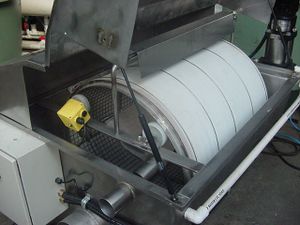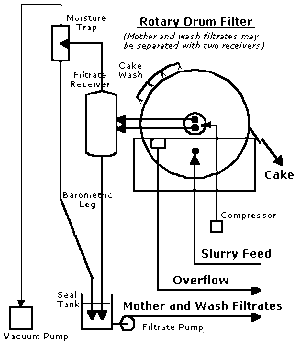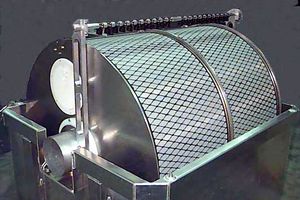Drum Filters
Rotary vacuum drum filter consists of a drum rotating in a tub of liquid to be filtered. The technique is well suited to high solids liquids that would blind or block other forms of filter. The drum is pre-coated with a filter aid, typically of diatomaceous earth (DE) or Perlite. After pre-coat has been applied, the liquid to be filtered is sent to the tub below the drum. The drum rotates through the liquid and the vacuum sucks liquid and solids onto the drum pre-coat surface, the liquid portion is "sucked" by the vacuum through the filter media to the internal portion of the drum, and the filtrate pumped away. The solids adhere to the outside of the drum, which then passes a knife, cutting off the solids and a small portion of the filter media to reveal a fresh media surface that will enter the liquid as the drum rotates. The knife advances automatically as the surface is removed.
Operational sequence
- Cake Formation: With the overflow weir set to a maximum the "apparent submergence" is normally 33-35% so the slurry levels between 0400 and 0800 hrs. Once a sector enters submergence vacuum is applied and a cake starts to form up to a point where the sector emerges from the slurry. The portion of the cycle available for formation is the "effective submergence" and its duration depends on the number of sectors, the slurry level in the tank and the bridge setting which controls the form to dry ratio.
- Cake Washing and Drying: After emerging from submergence the drying portion of the cycle commences and for non-wash applications continues to about 0130 hrs where the vacuum is cut-off. If cake washing is required the wash manifolds will be located from about 1030 to 1130 hrs and the remaining time to vacuum cut-off at 0130 is the portion allocated to final cake drying.
- Cake Discharge: After vacuum for the entire sector is cut-off air blow commences at about 0200 hrs in order to facilitate cake discharge. The blow, depending on the position of the tip of the scraper blade, will cut-off at approximately 0300 hrs. Drum filters are normally operated with a low pressure blow but on certain applications a snap blow is applied and to avoid the snapping out of the caulking bars or ropes wire winding of the cloth is recommended . Blow is used on scraper and roll discharge mechanisms but on belt discharge filters vacuum cuts-off when the filter media leaves the drum.
- Dead Zone: Once the blow is cut-off the sector passes through a zone blocked with bridges so that no air is drawn through the exposed filter media which might cause the loss of vacuum on the entire drum surface.
Video


